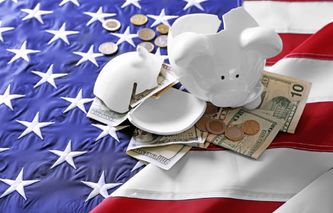Coins and physical banknotes dominated the world for centuries, but digital transformations have changed how we pay for goods and services. Many use debit and credit cards for payments, making cash transactions a thing of the past.
However, cashless societies are still a hypothesis, and the recent cash vs. credit card spending statistics reveal the true nature of things. So, let’s dive into the topic and see what the data says.
Top Ten Cash vs. Credit Card Spending Statistics:
Cash accounted for 18% of point-of-sale transactions worldwide in 2021.
By 2024, digital wallets and cards will account for 84.5% of e-commerce spend.
The overall electronic payments volume grew by 19% in 2021.
The average credit card interest rate in the US today is 23.55%.
The average credit card debt in the US today is $6,569.
The average consumer spends 12%-18% more with credit cards than cash.
73% of merchants prefer customers paying with credit cards or apps.
In 2024, cash POS payments volume could drop to 12.7%.
High-income households use credit cards more often than low-income households.
Only 17.51% of American adults prefer paying with physical banknotes and coins.
The Latest Credit Card vs. Cash Statistics
In 2021, two-thirds of adults worldwide made or received a digital payment.
Digital transformation is changing lives globally, and the data from 2021 shows that 76% of adults worldwide have an account at a bank or a mobile money provider. For instance, the rate stood at 51% in 2011 and 68% in 2017.
Recently, the shift toward digital is more pronounced in developing countries, where the percentage of digital payments increased from 35% in 2014 to more than 57% in 2021.
(World Bank)
Cash accounted for 18% of point-of-sale transactions worldwide in 2021.
The 2021 payment method statistics from Insider Intelligence reveal that coins and physical banknotes only account for 44% of point-of-sale (POS) transactions in the US. Globally, the percentage is even lower, with only 18% of transactions paid in cash.
In addition, experts predict that the market share of cash transactions will drop to around 10% by the end of 2025. The COVID-19 pandemic significantly reduced cash usage, causing a 32.1% drop worldwide in 2020.
(Insider Intelligence)
Credit cards accounted for 40% of point-of-sale transactions in the US in 2021.
Statista’s credit card vs. cash statistics for 2021 says that American adults preferred paying with cards even after the pandemic-induced measures were relaxed. Namely, credit cards accounted for nearly half of POS payments.
Similarly, debit cards ranked as the second most common payment option with a 30% market share, while cash payments only accounted for 11%.
(Statista)
Between 2019 and 2020, credit card transactions in the United States increased by around 6%.
Today, the leading credit card brands in the US are Visa, UnionPay, and MasterCard. So, by analyzing these providers’ latest credit card spending data, we can get a clearer picture of the modern consumer’s payment habits.
For example, records reveal that Visa owners made around 188 billion purchases in 2020, compared to 226 billion in 2021.
(Statista)
By 2024, digital wallets and cards will account for 84.5% of e-commerce spend.
According to World Pay Global’s analysis, cash usage in POS transactions dropped from 32.1% in 2019 to approximately 20.5% in 2020. The decline was even more pronounced in Europe, with a 33.6% reduction in POS volume.
Meanwhile, cash vs. credit card spending statistics for online transactions reveals that digital wallets, credit, and debit cards dominate the e-commerce world, where cash payments have little to no presence.
(World Pay Global)
The overall electronic payments volume grew by 19% in 2021.
The pandemic shifted consumer attention to online shopping, and global e-commerce registered a 17% growth rate in 2021. China experienced the most significant growth, accounting for nearly half of the global retail e-sales.
Consequently, consumers spent less cash in 2021, with the overall cash usage dropping by 15% compared to 2020.
(McKinsey)
The debit card market could reach $98.88 billion by 2027.
According to the latest credit card and debit card transaction volume statistics, the global debit card market reached $94.64 billion at the start of 2023. In comparison, the estimated market size in 2022 was $93.23 billion.
So, the positive growth rate shows that people worldwide love using their debit cards alongside credit cards. By 2027, the global debit card market could grow at a CAGR of 1.1%.
(The Business Research Company)
The average credit card interest rate in the US today is 23.55%.
The Federal Reserve raised the rates seven times in 2022, including four instances of 0.75 percentage points increases. So, although many Americans are using credit cards for everything, the recent interest rate hikes might deter them from reaching for their cards.
Moreover, people with a low credit score could expect an average APR of around 27.00%.
(Lending Tree)
The average credit card debt in the US today is $6,569.
In the second quarter of 2022, American credit card owners carried a balance of 53% on all active accounts. Of course, the increased interest rates prevent many US citizens from paying off their credit card debt.
Including debt from bank cards and retail credit cards, the national average among American cardholders with balances exceeds $6,500.
(Lending Tree)
Credit Card vs. Cash Statistics & Trends
The average consumer spends 12%-18% more with credit cards than cash.
Multiple studies reveal that people spend more when paying with cards than paying by cash. That’s why frequent card swipers have an increased risk of overspending and potential shopping addiction.
For instance, in 2016, the Federal Bank of Boston reported that the average value of non-cash transactions was $112, while the average cash transaction was only $22.
(Nerd Wallet)
80% of US consumers use debit cards for day-to-day purchases.
Unlike credit cards, debit cards are interest-free and have no annual fees. So, it’s not surprising that debit cards vs. cash statistics show a landslide victory for debit cards against physical banknotes and coins.
Namely, more than two-thirds of American consumers pay for everyday purchases such as gas or groceries with a debit card.
(Consumer Credit)
The best grocery rewards credit cards can offer up to a 6% cashback.
On average, Americans spend $5,174 yearly or $431 per month on grocery shopping, so it’s no surprise they look for money-saving payment options.
For example, many grocery rewards cards offer various benefits, including interest-free periods and cashback promotions.
(CNBC)
73% of merchants prefer customers paying with credit cards or apps.
We mentioned that credit cards encourage extra spending, but that’s not the only reason why merchants prefer customers paying with cards or apps.
Notably, eight out of ten US merchants agree that contactless payments are cleaner and safer for customers and employees. Likewise, 84% believe that these transactions are better for personal health than cash, and 81% of merchants intend to offer contactless payment options beyond the COVID-19 outbreak.
(American Express)
Tap-to-pay transactions for everyday purchases in the US grew by 100% year-over-year between 2019 and 2020.
Statistics for paying cash versus credit cards show that the overall contactless payments volume in the US increased by 150% between March 2019 and March 2020.
For instance, around 31 million Americans tapped a VISA contactless card in March 2020, compared to 25 million in November 2019. At that time, nine out of ten US card issuers were actively rolling out new contactless cards for their customers.
(VISA USA)
Credit cards accounted for 36.6% of American in-store retail transactions in 2022.
It’s no secret that credit cards are the US payments ecosystem’s backbone, accounting for more than a third of retail transactions last year.
And even though many consumers prefer cash over credit cards, the experts predict future growth for the credit card market. After all, JP Morgan Chase reported a 19.8% increase in credit card POS volume in 2021, while Wells Fargo had a 29.9% growth rate.
(Insider Intelligence)
In 2024, cash POS payments volume could drop to 12.7%.
Experts predict that credit and debit cards will hold approximately the same market share in the next two years, with around 22% point-of-sale volume each.
However, cash transactions could experience a significant decline, falling from 20.5% in 2020 to 12.7% by the end of 2024.
(Credit Cards)
Payment Method Statistics & Facts
By 2025, digital and mobile wallets could account for 53% of e-commerce payments.
As expected, digital wallets are the most popular e-commerce payment method worldwide. In addition, experts predict the popularity of mobile and digital wallets will only increase in the upcoming years.
On the other hand, credit cards ranked as the second most popular online payment method in 2021, with a 21% market share, but their popularity will likely drop in the coming years.
(Statista)
High-income households use credit cards more often than low-income households.
According to Forbes’ credit card vs. cash spending statistics, households earning between $100,000 and $149,999 use credit cards for 34% of their payments.
Interestingly, the percentage increases as households climb the socioeconomic ladder. For instance, families with yearly earnings over $150,000 use credit cards for 44% of payments.
(Forbes Advisor)
In the US, consumers pay for 47% of e-commerce transactions with credit cards.
Americans enjoy a longstanding familiarity with credit and debit cards, making these payment options the favorites for online transactions. In 2019, card owners generated $348 billion in online sales.
Although US citizens don’t pay for everything with credit cards, card penetration in the United States is among the highest in the world (2.44 for debit and 2.01 for credit cards).
(JP Morgan)
In 2021, the average cash held in a consumer’s wallet, pocket, or purse was $67.
The average value of on-person holdings dropped from $76 in 2020 to below $70 a year later, and this aspect can illustrate the tendency to avoid paying cash for everything and switch to credit or debit cards.
Yet, the average cash held in a consumer’s car, home, or elsewhere (store-of-value holding) jumped from $299 in 2020 to $347 in 2021.
(FRBSF)
Only 17.51% of American adults prefer paying with physical banknotes and coins.
After a comprehensive survey of more than 2,000 Americans, Finder discovered that less than a fifth of the adult population in the US prefers cash payments.
Meanwhile, 24.11% say they prefer credit cards, a percentage representing around 61.5 million American adults. Debit cards are the most popular, with 36.07% of respondents choosing this payment method.
(Finder)
Is Cash a Thing of the Past?
And there you have it—a comprehensive collection of the most relevant cash vs. credit card spending statistics for 2023 and beyond. As you could’ve seen, most studies show that virtual payments are displacing cash, but not everywhere and not completely. In other words, coins and physical banknotes are still in circulation and will remain so for the foreseeable future.
Although the idea of cashless societies offers many benefits, such as crime reduction and convenience, many are reluctant because the concept also includes technological dependency, reduced privacy, and increased governmental control. So, even though it lost its crown, the king is still very much alive.
Cash vs. Card FAQ
Do more people use cash or cards?
What percentage of transactions are in cash?
What are all the ways you spend more money when you pay with a credit card?
Sources:


.jpg)



